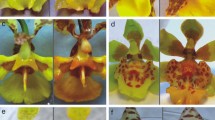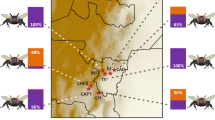Abstract
Pollination interactions between plants bearing oil-flowers and oil-collecting bees are regarded as specialized, and within the major group of bees, oil-collecting bees are considered a special functional group of pollinators, yet they encompass a great diversity, not only at taxonomic level but also in morphological and behavioral aspects. Since the functional group of oil-collecting bees is functionally diverse, we examined whether these bees, despite their gross commonalities, may be exerting divergence within and among oil-flowered species or, alternatively, promoting convergence to some general oil-flower morphology that can be pollinated by a functional range of oil-bees. To answer this question, we recorded pollinator assemblages of 18 taxa of Nierembergia, as well as the foraging behavior, visitation frequency, and morphometric characterization of all oil-collecting bees species that pollinate the flowers of those taxa, by field observations and sampling. We found that the pollinator assemblages of the species and varieties of Nierembergia largely differed among taxa. 14 species of oil-collecting bees, belonging to the genera Chalepogenus, Centris, Tapinotaspis, Caenonomada, Tetrapedia, and Arhysoceble, were recorded as pollinators of Nierembergia flowers. These pollinator species varied in multivariate body size, rewards-gathering behavior, and way they carry out pollination on flowers. According to our results, Nierembergia flowers are pollinated by five functional groups of oil-collecting bees that presumably promote divergence within and among Nierembergia taxa. Floral resource-harvesting behavior of oil-collecting bees species that pollinate Nierembergia flowers would be a key feature in the definition of functional groups and in the diversification of flower features in Nierembergia.







Similar content being viewed by others
Data availability
All data generated or analyzed during this study are included in this published article [and its supplementary information files].
References
Alves-dos-Santos I, Machado IC, Gaglianone MC (2007) História natural das abelhas coletoras de óleo. Oecol Bras 11:554–557
Armbruster WS (2017) The specialization continuum in pollination systems: diversity of concepts and implications for ecology, evolution and conservation. Funct Ecol 31:88–100
Augusto MN (2019) El rol de los polinizadores y la filogenia en la configuración fenotípica de los elaióforos en Nierembergia (Solanaceae). Graduation thesis. Universidad Nacional de Córdoba, Argentina
Buchmann SL (1987) The ecology of oil flowers and their bees. Annu Rev Ecol Syst 18:343–369
Carneiro LT, André CBDS, Takahasi A, Alves-dos-Santos I (2019) Interactions between oil-collecting bees and Krameria grandiflora (Krameriaceae) with emphasis on the role of specialized floral traits in the mutual fit. Arthropod-Plant Interact 13:213–226
Chacoff NP, Vásquez DP, Lomáscolo SB, Stevani EL, Dorado J, Padrón B (2012) Evaluating sampling completeness in a desert plant–pollinator network. J Anim Ecol 81:190–200
Cocucci AA (1991) Pollination biology of Nierembergia (Solanaceae). Plant Syst Evol 174:17–35
Cocucci A, Johnson SD (2017) Patterns and mechanisms in plant-pollinator interactions: Stefan Vogel’s contribution to contemporary pollination biology. Flora. https://doi.org/10.1016/j.flora.2017.05.019
Cocucci AA, Sérsic A, Roig Alsina A (2000) Oil-collecting structures in Tapinotaspidini: their diversity, function and probable origin. Mitteilungen der Münchner Entomologischen Gesellschaft 90:51–74
Córdoba SA, Cocucci AA (2017) Does hardness make flower love less promiscuous? Effect of biomechanical floral traits on visitation rates and pollination assemblages. Arthropod-Plant Interact 11:299–305
Cosacov A, Nattero J, Cocucci AA (2008) Variation of pollinator assemblages and pollen limitation in a locally specialized system: the oil-producing Nierembergia linariifolia (Solanaceae). Ann Bot 102:723–734
Fenster CB, Armbruster WS, Wilson P, Dudash MR, Thomson JD (2004) Pollination syndromes and floral specialization. Annu Rev Ecol Evol Syst 35:375–403
Ferreiro G, Baranzelli MC, Sérsic AN, Cocucci AA (2015) Clinal variability of oil and nectar rewards in Monttea aphylla (Plantaginaceae): relationships with pollinators and climatic factors in the Monte Desert. Bot J Linn Soc 178:314–328
Hunziker AT, Cocucci AA, Subils R (1995) Subtribu VIIb. Nierembergiinae Hunz. et Cocucci. Flora fanerogamica Argentina: Solanaceae, Córdoba. Proflora 15:3–17
Hunziker AT (2001) Genera solanacearum. The genera of Solanaceae illustrated, arranged according to a new system. Koeltz Scientific Books, Konigstein, Germany
Johnson SD, Steiner KE (2000) Generalization versus specialization in plant pollination systems. Trends Ecol Evol 15:140–143
Kearns CA, Inouye WD (1993) Techniques for pollination biologist. University Press of Colorado, Niwot
Maechler M, Rousseeuw P, Struyf A, Hubert M, Hornik K (2012) Cluster: cluster analysis basics and extensions. R package version 2.1.1
Martins AC, Melo GA, Renner SS (2015) Gain and loss of specialization in two oil-bee lineages, Centris and Epicharis (Apidae). Evolution 69:1835–1844
Maubecin CC, Boero L, Sérsic AN (2020) Specialisation in pollen collection, pollination interactions and phenotypic variation of the oil-collecting bee Chalepogenus cocuccii. Apidologie 51:710–723
Maubecin CC (2019) El rol de los polinizadores y la historia filogenética sobre la divergencia, integración y modularidad del fenotipo floral de Nierembergia (Solanaceae). Ph Thesis, Universidad Nacional de Córdoba. Córdoba, Argentina
Michelette ERF, Camargo JMF (2000) Bee–plant community in a xeric ecosystem in Argentina. Rev Bras Zool 17:651–665
Michener CD (2007) The bees of the world. Johns Hopkins University Press, Baltimore
Murúa M (2020) Different pollinators’ functional traits can explain pollen load in two solitary oil-collecting bees. Insects. https://doi.org/10.3390/insects11100685
Nattero J, Cocucci AA, Medel R (2010) Pollinator-mediated selection in a specialized pollination system: matches and mismatches across populations. J Evol Biol 23:1957–1968
Nattero J, Malerba R, Medel R, Cocucci A (2011) Factors affecting pollinator movement and plant fitness in a specialized pollination system. Plant Syst Evol 296:77–85
Neff JL, Simpson BB (2005) Rewards in flowers. other rewards: oils, resins, and gums. In: Dafni A, Kevan PG, Husband BC (eds) Practical pollination biology. Enviroquest, Cambridge, pp 314–328
Neff JL, Simpson BB (2017) Vogel’s great legacy: the oil flower and oil collecting bee syndrome. Flora 232:104–116
Oksanen J, Blanchet FG, Kindt R, Legendre P et al (2013) Package ‘vegan.’ Community Ecol Package Version 2(9):1–295
Pauw A (2006) Floral syndromes accurately predict pollination by a specialized oil-collecting bee (Rediviva peringueyi, Melittidae) in a guild of South African orchids (Coryciinae). Am J Bot 93:917–926
R Core Team (2019) R: a language and environment for statistical computing. R Foundation for Statistical Computing, Vienna, Austria. https://www.R-project.org/
Rasmussen C, Olesen JM (2000) Oil flowers and oil-collecting bees. Det Norske Videnskaps-Akademi. I. Matematisk Naturvidenskapelige Klasse, Skrifter 39:23–31
Renner SS, Schaefer H (2010) The evolution and loss of oil-offering flowers: new insights from dated phylogenies for angiosperms and bees. Philos Trans R Soc B 365:423–435
Roig Alsina A (1999) Revisión de las abejas colectoras de aceites del género Chalepogenus Holmberg (Hymenoptera, Apidae, Tapinotaspidini). Revista del Museo Argentino de Ciencias Naturales 1:67–101
Roig Alsina A (2000) Claves para las especies argentinas de Centris (Hymenoptera, Apidae), con descripción de nuevas especies y notas sobre distribución. Revista del Museo Argentino de Ciencias Naturales 2:171–193
Rupil G (2008) Señales florales de recompensa, cantidad de recompensa y su relación con los polinizadores en Nierembergia linariifolia Graham. Tesina de grado. Universidad Nacional de Córdoba
Sérsic AN, Cocucci AA (1999) An unusual kind of nectary in the oil flowers of Monttea: its structure and function. Flora 194:393–404
Sierra Muñoz JC, Siqueiros Delgado ME, Flores Ancira E, Moreno Rico O, Arredondo Figueroa JL (2015) Riqueza y distribución de la familia Solanaceae en el estado de Aguascalientes, México. Bot Sci 93:1–21
Simpson BB, Neff JL (1981) Floral rewards: alternatives to pollen and nectar. Ann Mo Bot Gar 68:301–322
Steiner KE, Whitehead VB (1991) Oil flowers and oil bees: further evidence for pollinator adaptation. Evolution 45:1493–1501
Valverde J, Perfectti F, Gómez JM (2019) Pollination effectiveness in a generalist plant: adding the genetic component. New Phytol 223:354–365
Vignoli Silva M, Auler Mentz L (2006) O gênero Nierembergia Ruiz & Pav. (Solanaceae) no Rio Grande do Sul, Brasil. Iheringia 61:139–155
Vogel S (1974) Ölblumen und Ölsammelnde Bienen. Akad Wiss u Lit Abh Math Naturwiss Kl 7:285–547
Acknowledgements
We thank Ana Clara Ibañez, Andrés Issaly, Florencia Soteras, Mauricio Cisternas, Cristina Acosta, Gabriela Ferreiro, Valeria Paiaro, Matías Baranzelli, Melina Mena, Santiago Benitez-Vieyra, Federico Sazatonil, Aimé Rubini Pisano, Sofía Maubecin, Nicolás Maubecin, Nayara Simoes Macayo, Federico Heredia, Georgina Nicolino, Denis Larrea, Stefan Wanke, José Rubén Pérez Ishiwara, Miguel Castañeda Zárate, Ania Vargas Ayalá, María Noel Augusto, and Soledad Chiabrando for field assistance in the uncountable sampling trips; Juan Fornoni for the research stay of CCM at Instituto de Ecología of the Universidad Nacional Autónoma de México and for the financial support for N. angustifolia field sampling; Arturo Roig Alsina and Antonio Aguiar for their help in bees identification and María Laura Guzman Rodriguez for revising the English version of the manuscript. This work was supported by funds of Consejo Nacional de Investigaciones Científicas y Técnicas (CONICET, PIP 201101-00245, PIP 11220150100690CO) and Ministerio de Ciencia, Tecnología e Innovación (FONCYT-PICT-2011-0837, PICT 2015-3089) to ANS. CCM, NR, NP, AAC, and ANS acknowledge the Consejo Nacional de Investigaciones Científicas y Técnicas (CONICET) as postdoctoral and doctoral fellowship holders and researchers.
Funding
This work was supported by funds of Consejo Nacional de Investigaciones Científicas y Técnicas (CONICET, PIP 201101-00245, PIP 11220150100690CO) and Ministerio de Ciencia, Tecnología e Innovación (FONCYT-PICT-2011-0837, FONCYT-PICT 2015-3089) to Alicia N. Sérsic.
Author information
Authors and Affiliations
Contributions
CCM, ANS, and AAC contributed to the study conception and design. Material preparation, data collection, and analysis were performed by all authors. The first draft of the manuscript was written by CCM and ANS and all authors commented on previous versions of the manuscript. All authors read and approved the final manuscript.
Corresponding author
Ethics declarations
Conflict of interest
The authors have no relevant financial or non-financial interests to disclose.
Additional information
Handling Editors: John J Couture and Heikki Hokkanen.
Publisher's Note
Springer Nature remains neutral with regard to jurisdictional claims in published maps and institutional affiliations.
Supplementary Information
Below is the link to the electronic supplementary material.
11829_2021_9864_MOESM2_ESM.eps
Supplementary file2 Pollinator morphometric variables. A. Dorsal view; B. lateral view; C. Ventral view. Measured traits (abbreviations): body length (BL), body width (BW), body height (BH), foreleg length (FLL), middle leg length (MLL), fore basitarsal length of the first leg (FBL), middle basitarsal length (MBL) (EPS 8018 kb)
11829_2021_9864_MOESM5_ESM.eps
Supplementary file5 Tetrapedia sp. bee collecting oil from the dorsal side of the petals of N. linariifolia flower (EPS 2853 kb)
Supplementary file6 Oil collection by Chalepogenus goeldianus in Nierembergia ericoides flower (MP4 4363 kb)
Supplementary file7 Oil collection by Chalepogenus neffi in Nierembergia tucumanensis flower (MP4 5297 kb)
Supplementary file8 Pollen collection by Chalepogenus goeldianus in Nierembergia ericoides flower (MP4 7350 kb)
11829_2021_9864_MOESM9_ESM.eps
Supplementary file9 Bee species clustering according to morphometric measurements. Biplot obtained by Cluster Analysis. The clusters are numbered and identified with different colors. Pollinator genus abbreviations: Ch. for Chalepogenus, T. for Tapinotaspis, C. for Centris, A. for Arhysoceble, Ca. for Caenonomada (EPS 1070 kb)
Rights and permissions
About this article
Cite this article
Maubecin, C.C., Rocamundi, N., Palombo, N. et al. Teasing out the functional groups of oil-collecting bees in the light of the pollination of Nierembergia flowers. Arthropod-Plant Interactions 15, 809–819 (2021). https://doi.org/10.1007/s11829-021-09864-y
Received:
Accepted:
Published:
Issue Date:
DOI: https://doi.org/10.1007/s11829-021-09864-y




